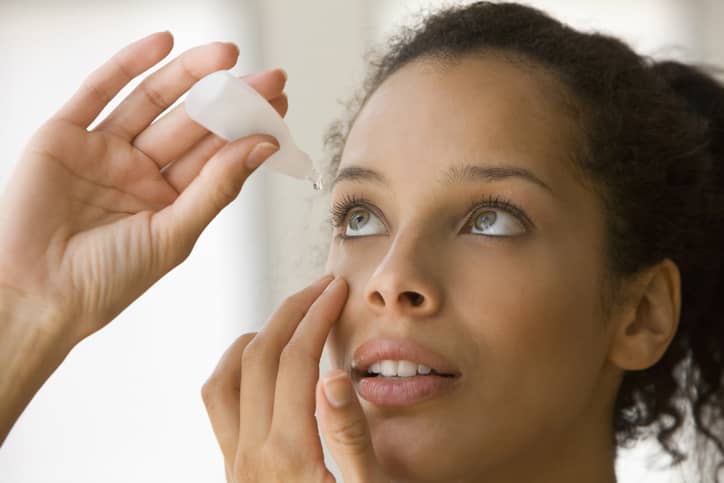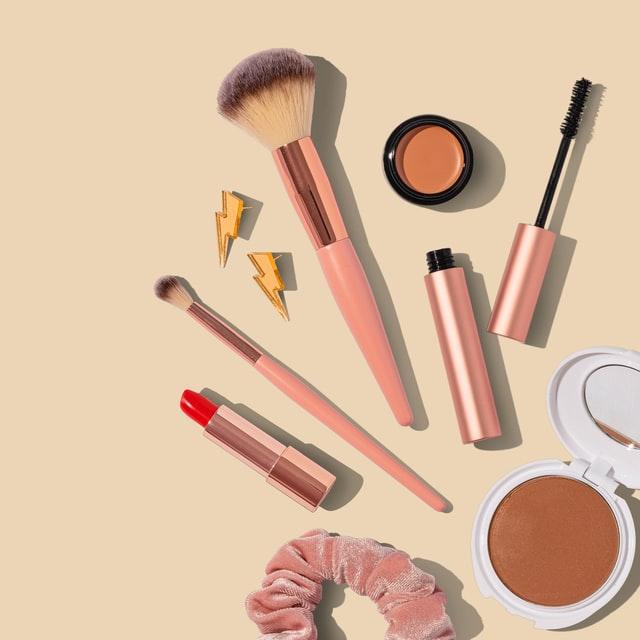Written and Medically Reviewed by Dr Leigh Plowman, Optometrist (updated Sept 2022)
Curious to learn more about Dry Eyes Symptoms, Causes, and Treatments?
Ever feel like you have to blink more when you’re concentrating? Or do you ever feel like there’s something in your eye?

| In this article, you’ll find health information: * Dry Eyes: Overview & Other Information * Dry Eye Symptoms * What Causes Dry Eye? * How To Fix Dry Eye * Dry Eyes Prevention |
You may have a condition called dry eye. That is your eyes don’t have enough quality tears to keep them nourished and moist.
Anyone can have dry eyes, but it is more common for people who stare at a computer for long periods.
Dry Eyes: Overview & Other Information
According to the TFOS DEWS II report, dry eye is a multifactorial disease of the ocular surface characterized by a loss of homeostasis of the tear film and accompanied by ocular symptoms.
In simpler terms, dry eye is a condition characterized by the lack of adequate tears in the surface of the eyes that causes some symptoms and discomfort.
Our eyes are normally protected by natural tears. Just like a wetsuit helps to protect you if you’re surfing or diving. Dry eye causes a partial or full breakdown of this protection.
Dr Leigh Plowman, Optometrist
What are the symptoms of dry eyes? Here are some symptoms you may experience if you have dry eyes.
- Sore eyes
- Red eyes
- Blurred vision
- Itchy eyes
- Vision that’s ‘on and off’
- Dry eyes
- Gritty feeling
- Eye fatigue or tired eyes
- Burning or stinging sensation
- Difficulty in opening eyelids in the morning
- Discomfort when wearing contact lenses
- Increased sensitivity to light, wind and/or smoke
- Excessive tearing or watery eyes
- Feels like something in your eye
Often, tears evaporate too quickly. This leads to irritation of the eyes.
As a natural reaction, our eyes may produce excessive tears when there’s discomfort or irritation caused by dry eyes.
Dry eyes at night are possible to experience these symptoms of dry eyes in one eye only.
It can also make it hard for individuals to drive due to increased light sensitivity.
In some cases, dry eye can also be associated with headaches or migraines.
Since headaches can be caused by several other conditions, it’s better to get a proper diagnosis and confirmation from a passionate eye doctor.
How the tear film works
Our tear film is important for our eyes and is made up of three layers:
- Inner mucin layer
- Middle aqueous layer
- Outer lipid layer
The inner mucin layer is made up of mucus that coats the eye’s surface. The mucus layer helps connect the cornea to the watery layer of the tears. It also helps in binding the tears and evenly spreading the water layer over the surface of the eye.
The aqueous or watery layer that makes up most of the tears contains the vitamins and minerals that help in keeping the eyes nourished. This layer is also responsible for keeping the eyes lubricated and getting rid of unwanted particles.
The outer layer is made up of oil or lipid which seals the tear film. It prevents the mucin and watery layer from evaporating. It is also responsible for keeping the tears’ smooth surface. The lipid layer keeps your tears from drying too quickly.
These layers form the tears that keep the eyes moisturized and nourished.
The tears help keep the natural balance in the eye to make it comfortable and clear.
When this balance is disrupted, dry eye occurs when there’s an inadequate and unstable tear film. This can happen for several reasons and can result in different discomfort and symptoms.
What is the main cause of Dry Eyes?
Dry eye can be caused by either a decrease in tear production or increased evaporation. Here are some of the risk factors:
Screen time
Do you stare at a screen frequently? Our eyes tend to blink less often when we concentrate. This exposes the normal tears to dryness and evaporation.
Aging
Tear production starts to decline as you age. This is also the reason why the dry eye is more common in people over fifty.
Health conditions
Certain health conditions can affect one’s ability to produce tears. Some examples are:
Eyelid problems
These conditions that cause the eyelids to not close the way they are meant to can lead to tears drying faster.
- ectropion (out-turning of the lids)
- entropion (in-turning of the lids)
Blepharitis is a common problem of the eyelids that contributes to dry eyes. Bacteria on the eyelids can affect the tear film and the eye’s surface.
Recent eye surgery
Eye surgeries like LASIK that lead to permanent changes in the surface of the eye can also cause decreased tear production.
The effects can be temporary or long-term.
Medications
The side effects of the following medications can also affect tear production.
- blood pressure medications
- Antidepressants
- sleeping pills
- heartburn tablets
- drugs for acne
- birth control pills
- hormone replacement therapy
- Hormonal changes, pregnancy, menopause and usage of contraceptives can also increase the risk of dry eyes.

- Cosmetics & skincare products can be toxic and harmful to the eyes. Learn more about mascara for sensitive eyes.

- One’s lifestyle and daily activities can also increase the risk of dry eyes. Wearing contact lenses, prolonged exposure to smartphones or computers, reading or driving for a long time and lack of sleep are just some circumstances that can contribute to dry eyes.
- Environmental conditions both indoor and outdoor, especially dry air can affect the eyes.
These are just some of the common causes of dry eyes.
If not treated well, dry eyes can lead to even worse complications like eye infections or permanent damage to the surface of the eye.
It is important to prevent dry eyes in their early stage. Know the symptoms and seek professional help as needed.
Dry Eye Drops
Artificial Tear Relief
Your doctor may recommend artificial tears for dry eyes. These are probably the most common dry eye treatment for dry eyes.
Most dry eye artificial tears are available over the counter. They help relieve the discomfort and irritation brought by the symptoms of dry eyes.
Drops can also help your eyes to feel smooth and clear.
However, artificial tear relief is only temporary.
Tap here for the best drops for dry eyes
Treating dry eyes start with a proper diagnosis by an ophthalmologist or a doctor of optometry. After a thorough check-up, they can determine if you have dry eyes, how severe your case is and prescribe you treatment options accordingly.
How to Fix Dry Eyes?
Dry eye treatments and procedures:
- Supplements
– can also help improve overall eye health. Adding omega-3 fatty acids, vitamin D, vitamin A, zinc, lutein, and zeaxanthin to your diet can help ensure the production of adequate tears and keep your eye healthy.
- Warm Compress
– a warm compress can help loosen debris in the Meibomian Glands. This helps the oils to flow better.
Prescription eye drops – help relieve eye inflammation. Unlike artificial tears, these eye drops require a prescription. Restasis, Cequa and Xiidra can help dry eyes.
- Meibomian Gland Expression
– a heat treatment for dry eyes that help open clogged eyelid glands (Meibomian glands) and improve tear production again. They use a special type of goggles to warm up and clear the clogged glands.
- Intense Pulsed Light (IPL) treatment
– this natural light procedure helps to switch on the Meibomian glands. It makes the glands younger and more active. It also helps reduce eye inflammation. IPL is a drug-free, drop-free treatment that works.
- Flushing tear ducts
– Flushing the tear ducts with normal saline out can help to clear debris and inflammation. Your eye doctor can flush the tear ducts easily at an appointment.
- Punctal plugs
– this procedure is done when there’s a need to temporarily or permanently close off the tear duct. This may help to retain tears much longer.
- Scleral contact lenses
– special contact lenses that are designed to trap moisture in the eyes. This is another standard remedy for severe cases of dry eyes.
- Amniotic membranes and drops
– these are like ocular bandages placed over the eyes to promote healing of the ocular surface. Dry eye drops with similar amniotic properties are also being formulated. This helps reduce eye inflammation.
Aside from these treatments and medications, you can also try some preventive measures at home.
Dry Eye Prevention
Simple Home Remedies for Dry Eyes
- Blink regularly when reading or when using your smartphones and computers. Don’t forget to take regular breaks from reading or screen time.
- Use a humidifier at home or in your workplace to add moisture to the air.
- If wearing contact lenses, make sure they are always clean to avoid bacterial buildup.
- Avoid blowing air directly to your eyes.
- Clean and massage your eyelids.
- Apply a warm compress to your eyes.
- Reduce cigarette smoking.
- Remove cosmetic products thoroughly. Wear non-toxic cosmetic products.
- Wear sunglasses outdoors to protect your eyes from the hot or cold wind, dust and other particles.
Use eye drops regularly to keep your eyes lubricated and nourished.
Keen to find the best dry eye products? Tap here to view the best products for dry eyes.
Does it go away?
Dry eye is a condition that needs to be maintained. Most people find that it does not permanently disappear.
Create a treatment plan with an eye doctor or dry eye clinic. Your doctor will be able to suggest a range of options for you.
The goal is to reduce dry eye symptoms and help to prevent deterioration.
Tap here to find a dry eye clinic in your area to take care of your eyes.
Visit an eye doctor to get a proper diagnosis and a dry eye treatment plan tailored just for you.
You don’t have to experiment to find relief for your eyes. See a passionate dry eye doctor today!

